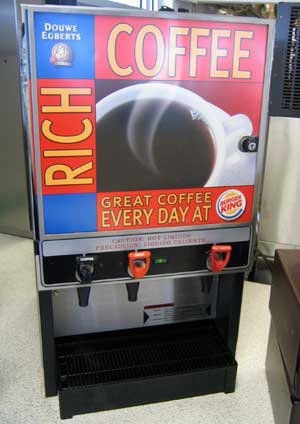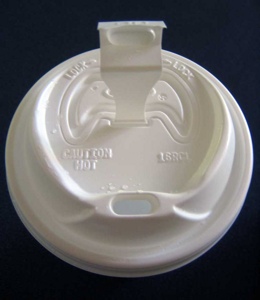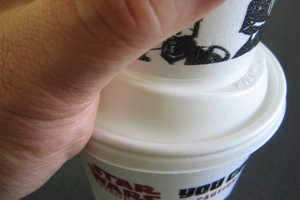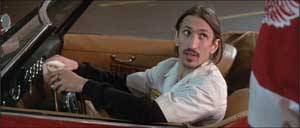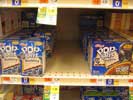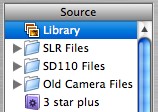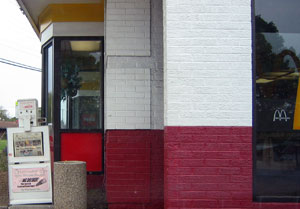
|
|
|
Monday 30 May 2005
Random Interesting Thing
In Praise Of Burger King Coffee and Dart Optima Lids The best ready-brewed coffee in America comes out of this machine:
This is the C-300 from Douwe Egberts Coffee Systems. It will make up to 1,700 cups of coffee per hour, which means that it’s serious overkill for the Burger King where this particular example is deployed. Douwe Egberts, despite being owned these days by Sara Lee, is not all that familiar a brand in the United States: but it makes sense to find the coffee at Burger King. There are a lot of strange Dutch influences on BK overall: aside from the coffee, there’s their practice of using a lot of mayonnaise; there’s the mayo-and-horseradish ‘dipping sauce’ for onion rings. Anyway, the really strange thing is the way in which this machine makes coffee. Douwe Egberts calls it a ‘brewer’, but it doesn’t really brew anything. It mixes coffee concentrate and hot water, and squirts the result out the nozzle. This sounds like it would be horrible, but it isn’t. Most people seem to be of the opinion that the quality of one’s coffee beans is the primary determinant of the quality of one’s coffee beverage. I don’t think this is true. Everyone who talks about coffee focuses on the beans. “Oh, these beans from the famed coffee hothouses of Ulan Bator are the greatest! And only $190 a pound!” “Well, you may have jumped on the Mongolian Coffee Bandwagon, but I’m a simple man, and I’ll stick with the beans that have been sifted out of Indonesian civet shit.” My experience has been that the brewing process has a far greater effect on the quality of the beverage. You can take supermarket can coffee and produce an excellent cup if you brew it properly: but if your coffee maker produces water that’s too hot, or too cold, or too full of crud from the machine not being cleaned, your coffee will be nasty, no matter what animal shit out the beans you’re using. Since the BK-DE coffee is actually brewed in a giant factory somewhere in Utrecht, in big machines carefully monitored by white-coated Douwe Egberts coffee scienticians with names like Freek and Geert and Maarten, it’s always brewed perfectly. Since they can guarantee the conditions under which the coffee will be brewed, they can probably manage to use lower-quality coffee, so Burger King can sell the resulting excellent product for $0.90, with unlimited refills to boot. And that’s not all. At the particular Burger King I go to, they use the new Dart Optima lid. Small things matter, and they usually matter quite a lot. The Dart Optima lid is sold primarily on the basis of its reclosability. In this department it’s not bad at all, but I don’t think that this is where it really shines. What’s super-fantastic about the Dart Optima lid is its shape. The top has a crescent-shaped rise on the top of it, with the hole for drinking out of at the highest point of the crescent: This raised crescent serves three purposes:
You can easily and securely carry two cups with this lid in one hand by stacking them and grabbing the stack between the two cups, pulling the top cup against the raised crescent on the bottom cup’s lid. I don’t think that any of these things are accidents. Somewhere in a top-secret research bunker near Lansing, there’s someone who sat down and thought about how something as invisible and mundane as the design of coffee cup lids could make life better. So get yourself to Burger King, and see whether their coffee isn’t better than Starbucks’, at less than half the price. And while you’re there, be sure to appreciate the lids. If your Burger King doesn’t use them, they’re pretty reliably found at Dunkin’ Donuts — which, unfortunately, has inferior coffee. Posted by tino at 13:58 30.05.05
Friday 27 May 2005
Cultural Note
Hazards Of Creeping Professionalism Professional is generally a compliment. Companies selling DIY stuff promise ‘professional results’. Cameras with more dials and knobs are sold as professional gear. People who buy these cameras hope that their friends will look at the resulting photographs and say, ‘Hrm, looks professional!’ Conversely, being seen as unprofessional is a very bad thing: unprofessional behavior at work is usually grounds for dismissal. An ‘unprofessional job’ is a sloppy one, maybe with glue oozing out the joints. I would argue that this veneration of ‘professionalism’ is a bad thing, and that it needs to stop. Professional serves as a useful term to distinguish things done for pay that are often done by amateurs (such as ‘professional baseball’ or ‘professional photography), but its use as a marker of quality or competence must end. There are costs, as well as benefits, to ‘professionalism’, and while these costs are worth the benefits in the traditional professions, they are emphatically not worth it in most, if not all, of the situations in which the term professional is now being fraudulently used. Traditionally, very few lines of work have been considered ‘professions’. The state of New York’s Office of the Professions recognizes and licenses forty-seven professions. If we lump things like podiatry and physical therapy together with medicine, and interior design and architecture with engineering, we come up with very few:
There are a few other fields, like banking and law and so forth which are also clearly professional work, but which are regulated by different organizations and thus not on New York’s list. In any case, we wind up with very few actual professions. Why are these things professions while other things are jobs? The dictionary suggests that the difference is that a profession involves prolonged training and formal qualifications, but that’s not very accurate. There are plenty of fields of work that require long training and formal qualifications but that are not widely considered ‘professions’; and some traditional professions don’t require all that much training, and require formal qualifications only because they are market-limiting ruses of the field’s trade association (massage therapists, for instance, are considered ‘professionals’ in New York). A better definition is that a profession is a job that has an important ethical component to it. It’s not like non-professionals are encouraged to lie and slack off at their work: but lawyers, physicians, accountants, etc. all have their own codes of ethics and conduct, to which they are supposed to adhere on their own. An even better definition involves the reasoning behind lawyers’ etc. professional codes: all true professions, it seems to me, are jobs where the customer is explicitly not always right. True professionals are not infrequently in the position of having to tell their clients what they don’t want to hear. A physician who didn’t tell his obese patient to eat less and exercise more would not be doing his job. A lawyer who didn’t warn his client away from a lucrative but illegal deal wouldn’t be doing his job. A surveyor who didn’t tell his client that, no, his driveway really was on his neighbor’s property wouldn’t be doing his job. And so on. The professional ethical codes exist partly to keep the professionals themselves in line, but their main purpose is (hopefully) to keep the professionals’ clientele from shopping around until they find an accountant, say, who’s willing to sign bogus balance sheets, or an engineer willing to construct a building that’s going to fall down. There have always been crooked lawyers, and as recent scandals have shown, it’s certainly possible, if there’s enough money involved, to bend the ethics of even the most prestigious accounting firms. Still, the system works remarkably well. When dealing with a real professional, part of the client’s responsibility is to listen to the professional’s advice: to ‘leave it to the professional’, so to speak. The problem comes when we start thinking of everything as a ‘profession’. Claiming to be a professional is a polite way of telling your client to shut up.
In Ferris Bueller’s Day Off, the dodgy parking-garage attendant reassures the reluctant Cameron by saying, ‘You fellas have nothing to worry about. I’m a professional’, immediately before taking Cameron’s father’s Ferrari back out of the garage for a joyride. Cameron is dubious (in an aside, he asks ‘Professional what?’), but the authority of the professional is such that gives in anyway. (See video of the scene here (requires Quicktime 7; 1:20, 8.7 mb) or here (Quicktime 6; 1:20, 10.2 mb).) This is absurd, of course, which is why you find it in the middle of a comedy. But there are a lot of situations in real life where the same fraudulent professionalism is used to shift power to the vendor in the customer-vendor relationship, and most (if not all of these) shifts cause, or have the capacity to cause, serious problems as they short-circuit the mechanism by which performance feedback is given. Police, flight attendants, waiters, teachers, politicians, maids, and seemingly everyone else today hold themselves out as ‘professionals’. Part of this is undoubtedly due to the fact that traditional professional work is typically well-compensated; the cargo-cult mentality says that if I, too, become a professional floor mopper, I’ll soon be driving a Mercedes and playing tennis. More easily attained, though, is the goal of evading immediate responsibility for, and criticism of, one’s acts. I’ve been thinking about this lately and will be referring to this creeping ‘professionalism’ in the future, so I thought it best to lay out the basic idea here. Posted by tino at 14:56 27.05.05
Tuesday 24 May 2005
Customer Service
Why The Grocery Store Is Always Out Of Things My comments on McDonalds’ (McDonald’s’? How do you do a possessive of a registered trademark that is itself already a possessive? McDonald’s themselves seem to prefer the ungrammatical ‘McDonald’s’ as the possessive, e.g. the large section about ‘McDonald’s commitment to diversity’ on their website. This is unpalatable because it seems to refer to something or someone called ‘McDonald’ and its or his commitment: Old McDonald had a diversity-enhancing, ‘minority’-boosting program, E I E I O. And through this program he hoped to avoid being sued, E I E I O. With a set-aside here, and a sensitivity initiative there, Old McDonald had his ass covered, E I E I O.) Now where was I? Oh, yeah: my comments on some of McDonalds’ (damn them, I’ll do it my way) customer-service issues being rooted in their procedures’ inherent conflicts with logic and grammar seemed to strike a chord with a bunch of people, so I’m going to shamelessly attempt a repeat performance: Bart by the barrelful, I always say. Today, I will explain why my grocery store is always sold out of so many items. Now, maybe your experience is different, but I find grocery shopping pretty frustrating. I generally patronize Martin’s in Front Royal. The Front Royal Martin’s is run by a guy who always wears a tie (so you can tell he’s the manager) but who seems to spend quite a bit of time in the store itself, rather than in his manager’s aerie counting doubloons or whatever it is most grocery-store managers do. Rarely do I go there and not see this guy in the aisles, stocking shelves, giving advice, or at least running around and giving a strong impression of Purpose. This could just be a ruse, a George-Costanzian scheme of always appearing incredibly busy while actually doing nothing, but the odds are against it. I assume that this guy is at least an above-average grocery store manager, partly because of his visibility, and largely because the store itself is above average. Oh, sure, there are some things that could use work: the salad bar’s closing seems tied mainly to the needs and desires of the staff, and not the needs and desires of Commerce; everything on the bottom layer in the fancy-cheese cooler tends to have been frozen at some point; the newspapers are badly placed; and the do-it-yourself tills are the inferior kind with the scales instead of the better (but larger) kind with the belts. These are, though, mainly minor things, and the store is, on the whole, good enough that I cannot understand how the competition (Food Lion) stays in business. The parking lots at both stores will attest to the fact that I am hardly the only person in Front Royal who prefers Martin’s to Food Lion. The only, or at least the chief, fly in the ointment is that Martin’s is often out of things. Very, very rarely — if ever — can we get through a full shopping trip without at least one item on the list being out of stock. Most recently, it was Grape Nuts cereal. I like Grape Nuts: so full of grapey and nutty goodness, they are. Eating Grape Nuts is like eating a bowl full of rocks, which is sometimes precisely what you need first thing in the morning. They make me feel like some kind of cartoon giant: I have been known to say ‘Fee Fie Fo Fum’ and to cackle maniacally while eating them. But, the last time I bought Grape Nuts, it was at the hated Food Lion, because they were out of them at Martin’s — they were out of them for weeks. And it’s not just Grape Nuts that they run out of. I went to the store today, and I took pictures of just some of the things that were out of stock: Note that today they did have Grape Nuts: but they’re well on their way to running out. They have plenty of South Beach Diet ‘wheats’, though. I didn’t get pictures of everything they were out of, partly because I didn’t want to get thrown out, and partly because after a while I didn’t have enough memory in my camera to get a picture of every last thing that was out of stock: I only had 1GB in there. I’m not really sure what Grape Nuts are made of, but I don’t think there are any particularly rare materials involved. I used to see a bumper sticker all the time, put out by the Mining Industry Council of Missouri, that said ‘If it can’t be grown, it has to be mined’. I have never seen a Grape Nuts bush, so I have to assume that the things are dug out of the ground by giant yellow machines somewhere in Michigan. (Similarly, as I can identify no vegetation or animal obviously associated with Cool Whip or Miracle Whip, I assume that these things are cracked out of some substance that’s pumped out of the ground in the Dakotas: Crude Whip. The Tino Universe is a very orderly, if inaccurate, place.) My point, anyway, is that there is not and was no shortage of Grape Nuts: Martin’s was just out of them. Things run out: I understand that. But what’s bizarre is that they were out of Grape Nuts for weeks, during which time — I went back every couple of days before I broke down and went to Food Lion — there were about a dozen boxes of something called ‘Grape Nuts Flakes’ on the shelf next to the bare spot where the Grape Nuts, in happier times, were to be found. (Much of the space formerly taken up by Grape Nuts Flakes has now been taken over by South Beach Diet ‘wheats’.) Nobody wants Grape Nuts Flakes. I know this intuitively: Grape Nuts and Flakes are polar opposites in the cereal world. If you want flakes, you don’t want Grape Nuts, and if you want Grape Nuts, you don’t want flakes. You want flakes, you buy Corn Flakes; if you’re a Post partisan, you buy Post Toasties (but not at Martin’s, because they don’t sell Post Toasties at all there). I don’t have to rely entirely on intuition, though: during the entire Grape Nut Drought, not one of those boxes of G.N. Flakes moved. How can this be? How can a store with a diligent and hard-working manager be sold out of a very basic and popular item for weeks while having twice the shelf space devoted to a similar item that not only doesn’t sell out, but that doesn’t sell at all? I’ll tell you how: it’s because supermarkets don’t, for the most part, actually function as markets any more. Or, at least, they don’t function as markets in the way you’d expect. The grocery business is famous for its very low margins. The food that Martins sells me for $100 they probably paid at least $90 for. That 10% margin — and I’m being generous — has to pay for the building, the staff, the electric bill, and the profit. How do they do it? Well, yes, volume is part of it, thanks for asking. But they also effectively increase their margins while at the same time reducing their costs by farming out part of their operations to their vendors, and charging those vendors for the privilege. Modern supermarkets are therefore less like ordinary shops, where the proprietor chooses a selection of goods, purchases them, and then offers them for sale, than they are like farmer’s markets, where individual vendors lease space from whoever owns the building. In the cereal aisle, it works this way: assume that Martin’s has 100 linear feet of shelving that they decide to dedicate to breakfast cereals. They hold onto, say, 10% of this for themselves, for their twenty-pound bags of crumbly and slightly off-tasting things with carefully non-infringing names like Froonkenberry, Cheer-Os, and Corm Flakes. They then charge General Mills some amount of money for the right to put their products on 20% of the shelf space, and Post and Kellogg’s some other amounts for 35% each. Kellogg’s, Post, and General Mills then develop marketing strategies and display guidelines, and send their guys in to stock the shelves with their products. Presumably the cereal people like this because they have more control over how their products are displayed: the Corn Flakes, a relative commodity, are always on the bottom shelf. Grape Nuts (and most of the other cereals for masochists) are on the top. In the middle, you find whatever bad ideas the cereal barons are really pushing at the moment: the children’s-movie-themed cereal of the month; Special K Now With Dried Lingonberries; Cheerios With Hollandaise Sauce; Atkins Brand Bacon Os; etc. The problem is that this puts even more intermediaries between me and the brave men who toil in the cereal mines. We are supposed to be living in an age of disintermediation, but the way it’s generally being carried out, I don’t think we’re reaping any benefits from it. In the old days, the grocery store bought its cereal from a grocery wholesaler who specialized in serving certain kinds of stores in a certain area; that wholesaler bought his wares from even larger wholesalers who specialized in certain types of goods. That wholesaler bought from the manufacturers and importers of those goods. By the time anything got to me, it had already been bought and sold four times. This is held to have been inefficient. Today, when I manage to buy a box of cereal, I’m effectively buying it straight from the manufacturer. The grocery store just maintains a large building for the purpose of keeping all of this stuff dry, and they handle the mechanics of the transaction. In many cases, I’d bet they don’t even pay the manufacturer until they sell something off the shelf. This is supposed to be more efficient, and it undoubtedly is. But it is more efficient at the cost of the most important function of a market — communication. In those mythical, halcyon Old Days, when I wanted something that was out of stock, I’d tell the guy who ran the store. If he noticed a number of people complaining about (say) the lack of Grape Nuts, he might just come to the realization that he should order more Grape Nuts. He’d tell his supplier to send five more boxes of Grape Nuts in the next order, and the Grape Nuts problem would be solved. Today, though, the guy wearing the tie at the grocery store doesn’t necessarily have anything to do with what’s on the shelves. The manufacturers determine what’s in demand by conducting surveys and focus groups, and by noticing what gets sold out before it’s restocked. They then apparently ignore most of this information and instead pack the shelves with whatever horrible fad the marketing department has fantasies of selling this week. There’s nothing wrong with having vendors stock the shelves: but as the grocers have farmed that part of their business out, they have a responsibility to their customers — and to themselves and their stockholders — to see to it that the vendors are acting in everyone’s best interest, and not just in their own. A lot of people complain about this. Usually, the complaints take the form of ‘Chain stores/restaurants/services stink’: very rarely, though, do people ask themselves why this should be. After all, a McDonald’s restaurant is a burger place with, ultimately, millions upon millions of dollars of capital behind it. Martin’s is part of an international conglomerate with enough volume to allow them, should they so choose, to have a full-time vice-president, with a staff, to do nothing but oversee their cereal aisles. So why is it, then, that you almost always get better results from a place with maybe a million dollars in mortgaged-to-the-hilt capital, where the owner has to take time out from fine-tuning his inventory to change the light bulbs and mop the floor? Because that small outfit not only has an actual channel for communication between customers and decision-makers, but it can make small adjustments to its operations. Large operations, despite their many advantages, seem totally unable to do this — and most of their ‘innovations’ have the effect, intended or not, of making communication and fine-tuning even more difficult. So even those items which are purchased and stocked by Martin’s, rather than by the vendors, don’t reflect the actual local demand: they reflect the opinions of someone making decisions with almost no relevant information. And so they run out of Grape Nuts, and everything else. Posted by tino at 17:54 24.05.05
Monday 23 May 2005
General Idiocy
Panic Now! We’ll Tell You Why Later This little promo spot perfectly lays out, I think, just why I loathe local TV news. It ran during The Simpsons on Sunday night. It’s nothing new, but it’s particularly shameless, even for Washington’s local Fox affiliate — which is saying a lot.
VO: In just five seconds, your child is at risk! So: Your children are within seconds of being ‘at risk’, and within ‘minutes’ of being ‘victims’ of sexual predators and violent criminals. And WTTG will tell us how we can stop it — in another twenty-seven hours. Either they are just stirring the pot of Fear because they don’t have the talent or intellect to do anything else, or they are horribly irresponsible. I do not understand how anyone with a modicum of self-respect can have anything whatever to do with local TV news, either on the production or the consumption side. Undoubtedly this has something to do with THE INTERNET. A Quicktime 6 version has been provided for people running Windows, for which there is no QT7 yet. Your Child In Danger! (spot) 2.7mb, 0:19 Quicktime 7
Your Child In Danger! (spot) 3.7mb, 0:19 Quicktime 6
At one point, the anonymous ‘investigator’ poses as a 13-year-old girl in a ‘chat room’ and attracts the attention of someone who says he’s 18. Even though nothing sexual has gone on, the ‘investigator’ claims that the 18-year-old has already committed a crime by not leaving immediately upon discovering that this other person ‘is’ 13. The story then cuts from an 18-year-old propositioning someone he thinks is five years younger, to a shot of kids who look to be about seven or eight years old. Wonderful. Your Child In Danger! (full thing) 30.6mb, 5:46 Quicktime 7 Your Child In Danger! (full thing) 64.9mb, 5:46 Quicktime 6 Posted by tino at 16:19 23.05.05
Monday 16 May 2005
Customer Service
McDonald’s Needs A Taxonomy I was at McDonald’s this afternoon, and after I was told off by the counter person for specifying the size of my meal-based order after the special instructions about the burgers, it struck me that McDonald’s desperately needs a Taxonomy Of Fast Food. A taxonomy is, as the word itself suggests, a scheme for arranging things; in practical use, it has a strong connotation of a hierarchical arrangement. Carl Linnaeus developed a system of naming biological entities according to a hierarchy. In the Linnaean taxonomy, everything is, to begin with, a member of a kingdom. There are between three and six biological kingdoms, depending on who you ask. The simplest approach is to hold that there are three: animals, plants, and wee beasties. Going on down the hierarchy are phylum, subphylum, class, subclass, order, family, genus, species. Thus you have: Animalia It’s very convenient, and it’s stable from language to language: it thus facilitates unambiguous communications, which is good. And this ability to communicate clearly is what McDonald’s — and a lot of other businesses — almost totally lack. Starbucks is one of the places that gets it right. Here’s a Starbucks drink you might order: Venti iced americano with room Venti means twenty in Italian, and it’s one of Starbucks’ trademarked terms for size: it means twenty ounces. Iced you can probably figure out on your own; americano is Italian for ‘American’. A lot of places in Italy only have espresso machines, so if you want what would be considered a cup of coffee in the United States, you ask for a caffé americano, i.e. espresso mixed with hot water. (American-themed places like burger restaurants serve ‘authentic’ caffé americano and have big US-made Bunn coffee makers on display just as places in the US show off their giant Marzocco machines from Italy.) Room means don’t fill the cup up to the top: this way there’s room for cream, half-and-half, or whatever. If you show up and order a ‘Venti americano with room, on ice’, the Starbucks person will read the order back to you in the standard Starbucks order, every time: ‘Venti iced americano with room’, thus subtly training you to order it that way the next time. This is important, because it streamlines Starbucks’ operations. As soon as the word ‘Venti’ is out of your mouth, someone’s grabbed a 20-ounce cup. When you say ‘iced’, they can scoop ice into the thing. When you say ‘americano’, they start throwing in espresso and water; and when you say ‘with room’, they know to stop filling the cup before the water gets to the top. You have to say things in some order, because trying to say ‘Venti’, ‘iced’, ‘americano’, etc. all at the same time wouldn’t be very clear, and you might injure your tongue besides. But Starbucks has carefully thought about the order in which you say these words, because even something as subtle as this can help or hurt their business. The size comes first, because you’ve got to have a cup in your hand (and thus know the size of the drink) before you can start doing anything: but an ‘iced americano’ is also quite different from an ‘americano with ice’. If you make an americano (i.e. espresso plus hot water) and then put ice in it, it’s not going to be cold, and because of all the ice melt it’s going to be watery — and never mind that you can’t regulate the ‘room’ easily this way. If you pour espresso over ice, then add more ice to make up for the ice the espresso melts, and then fill the cup with cold water, it’s a very different drink. So: 20-ounce cup, put ice in it, put espresso in it, put water in it, leave some room. All drinks are subclasses of one of the three Sizes, then Iced-State. More complex drinks might be subclasses of Whipped or No Whip; Caffeinated (default) or Decaf. A ‘Venti one-pump vanilla decaf skim cappuccino’ reflects the order of its construction just as the iced americano does. (I will here not veer off into a discussion of adjective order in general, except to say that in English, it’s nearly always opinion, size, age, shape, color, origin, material, qualifier: ugly big old lumpy round green French plastic bag.) By having a nomenclature that not only describes a drink, but that describes the way the drink is made, Starbucks saves a second or two on every drink: maybe even more, because it cuts down on mistakes. Starbucks says they have 33 million customers per week, and if we assume that each one of them buys 1.5 drinks during the week, saving two seconds per drink saves Starbucks over 23,800 hours (or three man-years) per year. McDonald’s, on the other hand, gets this exactly wrong: if you were trying to come up with a system that fosters frustration and confusion, you’d have a hard time doing better. Not only do they lack a clear taxonomy, they also are fighting an uphill battle with grammar. To begin with, the menu doesn’t actually list everything they sell. They still offer a ‘two cheeseburger meal’ (i.e. two cheeseburgers, fries, and a drink), but the customer just has to know this. If you order two cheeseburgers, fries, and a drink à la carte, it’s more expensive. Then, there’s the question of what order to ask for all of this stuff in. The McDonald’s electronic till requires the size first: that is, a large two-cheeseburger meal is a separate item from a medium two-cheeseburger meal — which what you get if no size at all is entered. In McDonalds’ without do-it-yourself soda fountains, or in the drive-thru, you then have to specify what you’d like to drink. Or maybe you first need to tell them you want extra pickles? Based on my experience this afternoon, I think they want you to ask for ‘a large two-cheeseburger meal with extra pickles and a Coke’. Which is nuts, because the large has nothing to do with the cheeseburgers, and the fries are totally unstated. The pickles or whatever special instructions you have about the burgers are marooned out there with the drink, and grammatically the pickles relate to the meal, not the burgers. I don’t want a meal with pickles: I want a meal, one (or two, as it happens) of the constituent parts of which I would like with extra pickles. How much simpler it would be if they recognized that grammar exists for a reason! Everyone who spoke English would already know what to ask for: ‘two cheeseburgers with extra pickles, large fries and a large Coke’. If they really wanted to discourage people from choking down their burgers dry and unaccompanied by fried potatoes, the computer could give a discount to compliant orders, without requiring the humans to screw around with contradicting everything they subconsciously know about language. Posted by tino at 16:08 16.05.05
Sunday 15 May 2005
Government Idiocy
Here We Go With The Fat Cat Bashing Philip Greenspun makes a good point about last week’s idiocy involving a small plane over Washington; and his commenters points out that, if the government really believed that there was much of a chance of a bomb being aboard the plane, why did cops rush right up to it after it landed, with guns pointed? Aren’t you usually better served by maintaining a good distance from a bomb? When all this was going on, I was driving around and thus not near a TV. Instead, I was listening to the Fox News TV audio on the XM radio. Fox News seems to have the most entertaining coverage of things like this, because they are willing to immediately veer into conspiracy theory and extreme possibilities. (“Do you think there might be a nuclear weapon on board, General?” “Well, obviously I don’t know anything about what’s inside that plane, but it wouldn’t surprise me one bit if there were. Also, it’s possible that that Cessna 150 is equipped with air-to-air missiles, so our Brave Boys up there had better look out.”) You can tell that the people on the other news channels are just itching to go down the same path, but they usually manage to restrain themselves. Anyway, the interesting thing was that Fox had on a guest bloviator, one John Loftus. Loftus is a former federal prosecutor and now apparently a full-time author and pundit. He made the astute observation that, given that this was such a small plane (and thus not likely to be able to do significant damage to a building, even if it were full of explosives), the evacuations of buildings in Washington were silly. He went on to say: Now what you have here is a little tiny airplane that should have—90% of the time, this happens with very rich people who think they’re above the law. They think they can afford a plane. They don’t care about these air defense zones. 9/11 applies to everyone else, and not them. […] Now it will probably turn out it’s just some arrogant businessman who wanted a closeup look at the Capitol Building. Now ironically, we have laws where we can seize a Cadillac from a drug dealer; if he uses somebody else’s car at a crime it gets seized. We don’t have a law to seize that airplane, and we should. Every time one of these idiots sends all of our people in DC scurrying around getting out of his way, take the little plane away. Make Daddy pay for it. Hit him in the pocketbook…. (I found a transcript here.) What the hell? To begin with, most of you probably drive a car that costs more than a Cessna 150: I certainly do. “Make Daddy pay for it”? “Arrogant businessman”? It’s important to remember that these statements were made while the plane was still in the air; a few minutes later, those with TVs were treated to the sight of the occupants of the airplane being yanked to the ground and handcuffed. When these statements were made, nothing was known about the people in the plane. (Later, they turned out to be a 69-year-old pilot and his student. No word on whether either of them are arrogant or businessmen, but that they are not being charged with any crime would seem to indicate that there was no mens rea: not that that’s always a consideration these days.) Had Mr. Loftus suggested that the people in the plane were ‘stupid, arrogant illegal aliens’, he would have been held up by the host (Linda Vester) and asked to explain himself — after she’d delivered a little speech about how most illegal aliens weren’t pilots at all. If he’s said that the people in the plane were probably black, he’d have been shouted down by the audience (this was on during Dayside, Fox’s midday questions-from-the-audience show). As it is, they applauded his suggestion that what was needed wasn’t a $500 device that could eliminate the possibility that pilots would get lost, but rather more power on the government’s part to seize private property without due process. And this was on the ‘conservative’ news channel. This is what ‘conservatism’ has come to, it seems: knee-jerk police-statism and reflexive disgust at the imagined wealth and therefore ‘arrogance’ of people you know nothing about. It’s worthy of Atlas Shrugged. Posted by tino at 11:50 15.05.05
Thursday 12 May 2005
Unpredictability
Unpredictability At Work The other day, a part literally fell off my car. Unfortunately, this car was manufactured by General Motors, so this in itself wasn’t particularly unpredictable. ‘Like a rock’, my ass: some particularly crumbly rock, perhaps. Today, I called the Chevy dealer and asked if they had the part, a license-plate light housing, in stock. They said they did, and that it was only $11.52. So many of them fall off, you see, that they can pass the savings on to me. How do they do it? Volume. Anyway, I checked the hours on the dealer’s website:
But when I got there at 5:30, the parts department was closed. It appears that the parts department closes at 5:00, and has always done so. The service guy who was there was nice, and he even apologized to me after checking that the website indeed had the wrong hours on it. He couldn’t do anything for me, though. Since the parts department of any car dealer has a lot of valuable, easily-fenced goods in it, they don’t give the keys to everyone. The apology is how you know that this takes place in a small town. In the suburbs or the city, I’d have been made to feel that I was in the wrong. The other way you know that this takes place in a small town is that, an hour later, they have actually updated the website:
Though this doesn’t explain what the service guy was doing there with the door unlocked at 5:30. And, of course, it doesn’t explain why it fell to me, a customer, to expose this problem for them. This isn’t the first time I’ve run in to a problem like this, particularly when dealing with websites of non-technical people. It’s better to give out no information at all than to give out inaccurate information, but a lot of people — and most car dealers would definitely fall into this category — aren’t particularly aware of their web presence from day to day, and it never occurs to them to make sure that they’re not spreading disinformation. Posted by tino at 18:35 12.05.05
Sunday 08 May 2005
Technology
Another iPhoto Bug Fix About a month ago, I wrote that turning off iPhoto sharing had solved a lot of my iPhoto problems. It did: iPhoto had been rendered entirely unusable because it would freeze (with the spinning beachball, sometimes called the ‘spinning pizza of death’ or SPOD) shortly after launch. I might be able to select a photo before it would freeze, but I couldn’t actually do anything with the program That helped for a while, at least, but in the past couple of weeks, I’ve been hit with a very similar problem. I start iPhoto, and then any time from a couple seconds to a few minutes later, the program would freeze with the beachball etc. In this state, I could at least get a few things done: there was generally enough time for me to import photos from my camera or find a couple photos and export them to something else. If I wanted to find a couple more photos, then, I’d have to force-quit iPhoto, launch it again, and start over. Hardly optimal. I regularly troll through the Apple iPhoto discussion boards. I haven’t found them to be all that useful, honestly. Most of the people there have different problems from mine, and most of the people offering suggestions are, honestly, idiots. Nearly every thread involves a number of suggestions to upgrade to the latest version, even if the complainant initially specified that he’s got that version. People are constantly advising people to ‘repair permissions’ or to ‘rebuild the library’. This last one is at least relevant and obscure. Anyway, today I actually found something that helped. It was originally posted in January, but I missed it then in all the ‘repair permissions’ threads. It’s simple, and it has once again made iPhoto usable for me: I turned off the ‘last roll’ and date-based auto-albums. Specifically, I did this in the terminal:
No problems since then. Admittedly, it’s been only a few hours since I did this, so the permanence of this fix is still somewhat up in the air: but iPhoto has been more stable in those few hours than it’s been in months. Posted by tino at 19:36 8.05.05
Thursday 05 May 2005
General Idiocy
Those Suave Brits There was a general election today in the UK, and the BBC is currently doing their peculiar frantic election coverage. The UK has a much saner system for counting votes than we have in the United States: voters make marks on little bits of paper, which are then counted locally. The drive toward opaque, computer-driven voting in the United States is justified on the basis that computerized votes can be counted faster: they don’t seem to have a problem with this in Britain. Anyway, once the ballot papers are counted, the vote totals for each district (for the purposes of a general election, they call ‘em ‘constituencies’ there, since Britain is full of overlapping political jurisdictions, and I don’t think that parliamentary constituencies necessary correspond to any other boundaries) are read out by sweaty fat guys in ill-fitting suits. The BBC have cameras all over the country in order to put these guys on TV. This takes a while, and since it’s still early in the counting at the moment, there’s a lot of time to kill in between announcements. If you’ve ever seen Monty Python’s election sketch, you’ll have the general idea: a remote shot from some election headquarters, followed by lots of strangely frantic commentary and shots of the swingometer. Much of this involves panel discussions and talking-head shots with people who I don’t recognize but who are probably quite famous and important people in the UK. It’s very difficult for an American to really judge how important a British person is from his or her appearance: there is a distinct tendency in that country for people, even when they’re on television, to look like they’ve just rolled out of bed. At the moment, they’ve got Boris Johnson on. Mr. Johnson is a Conservative MP and editor of The Spectator: but he looks like he’s just come from sticking his finger in an electrical socket. It wouldn’t surprise me to find that he’s wearing mismatched, gaudy socks. No wonder Americans look so blow-dried and made-up to Brits. But none of this is actually my point. My point is this: the BBC are also holding a different kind of political party, i.e. an affair where there are drinks and hors d’oeuvres and politicians. A moment ago, they cut to this shindig, where it appears the BBC have hired a George Bush impersonator. That’s a little strange for what’s supposed to be news coverage, but that’s not the half of it. The only thing that made this guy a George Bush Impersonator and not just some guy with bad hair is that he speaks with a Texan accent and uses a lot of malapropisms. He refers to Condoleezza Rice and ‘her Uncle Ben’. In case you live under a rock, Condoleezza Rice is the Secretary of State of the United States, and also an African-American. Uncle Ben, also African-American, is the mascot for a line of rice products and related foods. He refers to the ‘prime sinister’, ‘Barry Blair’, and the ‘chandelier of the exchequer’, ‘Charlie Brown’; to ‘Charles F. Kennedy’; to ‘Michael Howard the duck from the convertible party’. (Tony Blair is the prime minister, and the UK’s analogue to the American Secretary of the Treasury is the Chancellor of the Exchequer; Charles P. Kennedy leads the Liberal Democrats; and Michael Howard, the leader of the Conservatives, is not a duck.) In the end, he comes on to the interviewer, saying ‘you’re hot; I looked you up on the web’. You can see the whole two-minute thing in glorious Quicktime by clicking on the image of the BBC interviewer giggling at this jackass:
American TV news is uniformly horrible, but you would never, ever see anything like this presented during a news broadcast. You might see it on Saturday Night Live, but even there it wouldn’t be so crude, insulting, and badly-done. You might think of this the next time someone complains about ‘freedom fries’ or any other instance of Americans pointlessly knocking some other country. And you might think of it, too, the next time you see the BBC reporting on the United States. Posted by tino at 20:48 5.05.05
Monday 02 May 2005
Corporate Idiocy
The Woes Of The Newspaper Industry According to Goldman Sachs as reported in this article in Editor & Publisher, the first quarter of 2005 was the newspaper industry’s ‘weakest quarter in years’. Now, it must be kept in mind that this was their ‘weakest quarter’ because their revenue only increased by 2.6%, or faster than the official rate of inflation. And it must be kept in mind that in the first quarter of 2005, there were no Christmas sales being advertised by the department stores, and no major elections (or, for that matter, much compelling news of any kind) that would have encouraged people who don’t regularly read the newspaper pick it up. I suspect that the third and fourth quarters of 2004 were some of the newspaper industry’s best quarters in years. Still, though, the general trend seems to be a downward one, even if it’s still in the range of ‘slowing growth’. Now, what do you do if you’re selling something and you would like to sell more of it? Or, rather, what don’t you do? A lot of things, potentially. But one strategy that I’m sure does not lead to increased revenues is making your product harder to purchase. Nevertheless, this is exactly what the newspaper people are doing. I do not subscribe to any newspapers on actual paper. Not only does this tend to lead to a horrible mess in the house, but ‘home delivery’ here means that the newspaper gets left a little over a mile from the house. I usually get my news online, but when I eat breakfast or lunch out, I like to buy a newspaper. Using a computer in a public place generally makes me feel like a complete tool, and besides, the hard-copy newspaper is a much, much better method of presenting information than a computer screen. I wind up finding a lot of stories in an actual newspaper that I would have missed online. Alas, this really isn’t possible any more. In Front Royal, nearly all of the newspaper machines have now been removed. On the south end of town, there used to be a large cluster of newspaper machines outside the Food Lion, and another centrally located outside the post office. The machines at the post office disappeared a few months ago, and the ones at the Food Lion last week. Not all that long ago, there were newspaper machines all over the place: on the curb at the grocery store, chained to street signs in the middle of suburban subdivisions, at bus stops, at the post office and near almost any other ‘official’ building, and outside just about all restaurants. No more: the newspaper vending machine is almost entirely extinct outside large urban downtown areas. There are still a very few machines here and there in Front Royal, but to the best of my knowledge there’s only one machine left in town that sells the Washington Post, and, being the only Post machine in town, it’s generally sold out by 8:30 a.m.
This box at McDonald’s sells the Winchester Star. I have no idea how that got picked instead of one of Front Royal’s own two newspapers (only one, admittedly, is a daily), or the Washington Post or the Washington Times or anything else. The McDonald’s used to sell USA Today over the counter, but I have not seen them there for months. I’m not sure whether they have discontinued the practice all together, or whether they just consistently sell out by 8:00 a.m. and have never bothered to increase their order. Today, if you want to buy a newspaper in Front Royal, you need to go inside somewhere. The best selections are at Martin’s (a grocery store) and a 7-Eleven on the north end of town. Both of them have the Washington Post and Times, the Wall Street Journal, the New York Times, Post, and Daily News, the Baltimore Sun, USA Today, Baseball Weekly, Sporting News, the local papers from Front Royal, Winchester, etc., and things like the Horsey Set Weekly or whatever the hell those papers are. Everything’s up to date in Front Royal. If you go to the 7-Eleven, though, you will generally find yourself in line behind half a dozen people buying lottery tickets. Selling lottery tickets is one of the least efficient things the store does; I suspect that the process is deliberately slow in order to impress the rubes and to make the whole thing seem like less of a scam. It’s also phenomenally profitable, so there’s no real push to streamline the operation. In short, it can easily take five minutes — not counting the time it takes to park your car, walk into the place, walk back to your car, and get out of the parking lot — to buy a newspaper at 7-Eleven. And Martin’s is even worse, though for entirely different reasons. Like most modern grocery stores, there are two entrances. At Martin’s, these are at the north and the south ends of the store. The newspapers are all located near the north entrance, oddly placed next to the Rug Doctor machines and the 15%-commission loose-change-sorting machine, beyond the cash registers. The most efficient way to buy a newspaper at Martin’s is to enter through the north door, grab a paper, walk around the end of the row of tills, walk about 150 feet to the self-service checkouts (which are located next to the south entrance), scan your paper, insert your money at the (loud) prompting of the machine, and collect your receipt. At this point you can walk the 150 feet back to the north entrance and make your way to where you left your car in the parking lot. In the grand scheme of things, this isn’t so bad: you have to walk 300 feet! To get news from all over the world for thrity-five cents! The horror! But it’s incredibly complicated, and it fails utterly to take into account the way that people actually buy and consume newspapers. Few Americans visit the grocery store every day, and fewer still make a detour around the front of the cash registers to see what might be on offer there before they proceed into the store proper. The busy time of day for the grocery store is about 6:30 p.m., by which time the news in the paper is at least 18 hours old: can anybody guess why these newspapers don’t sell in large numbers? Part of the problem — perhaps all of it — is that the newspaper companies do not actually sell newspapers to people directly. You may have seen trucks roaming around that say ‘Hometown Star-Herald’ on the side, and the few newspaper boxes that survive outside of downtown areas all carry the same graphics, but these trucks and machines are, with very few exceptions, not owned by the newspaper. They’re owned by independent distributors. Even if you call the newspaper’s circulation office to order up a subscription, you are not actually buying the newspaper from the publisher directly: they sell the paper to a guy with a van and a supply of long plastic baggies. He then throws the paper on your lawn every morning and sends you a bill. In most places, you will note that you pay your newspaper bill to ‘Hiram J. Bundy’ and not to ‘Hometown Star-Herald Co.’ The thing is, the guy who owns and fills the newspaper machines also sells newspapers to Martin’s and 7-Eleven, who sell them mainly in order to get people into their stores. The stores don’t want the newspaper machines around, and the newspaper distributor is only to glad to be rid of the machines and the headaches of theft, vandalism, and zoning that come with them. So you wind up with newspapers being sold in ways that make no sense, and the newspaper companies appear to be either unaware of or uninterested in the problem. If I start to see the newspaper people take real steps to make their product simpler to purchase, I’ll suspect that they might be turning themselves around. Not before. Posted by tino at 10:34 2.05.05
|
